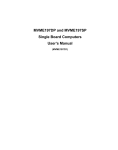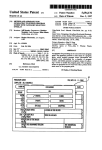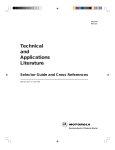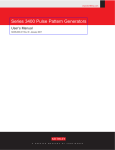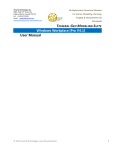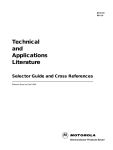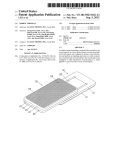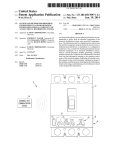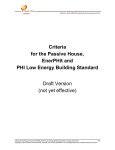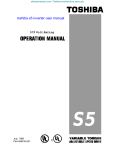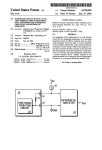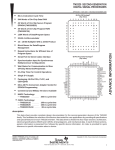Download Method and apparatus for performing saturation instructions using
Transcript
US005959636A United States Patent [19] [11] Patent Number: Lin et al. [45] Date of Patent: 5,959,636 Sep. 28, 1999 [54] METHOD AND APPARATUS FOR PERFORMING SATURATION INSTRUCTIONS USING SATURATION LIMIT VALUES Sun Micro., “SPARC Technology Business”, Sep. 1994. Y. KaWakami, “A Single Chip Digital Signal Processor for Voiceband Applications”, IEEE, pp. 40&41, Feb. 13, 1980. J. Shipnes, “Graphics Processing With the 88110 RISC”, [75] Inventors: Derrick C. Lin, Foster City; Mehrdad Mohebbi; Kay K. Huang, both of San Jose, all of Calif. Motorola Inc., “MC88110 Second Generation RISC Micro processor User’s Manual”, 1991. IEEE, pp. 169—174, 1992. Motorola Inc. “Errata to MC88110 Second Generation RISC [73] Assignee: Intel Corporation, Santa Clara, Calif. [21] Appl. No.: 08/606,328 Microprocessor User’s Manual”, pp. 1—11, 1992. Motorola Inc., “MCC88110 Programmer’s Reference Guide”, pp. 1—5, 1992. [22] Filed: Intel, “i860 Microprocessor Family Programmer’s Refer [51] Int. Cl.6 .................................................... .. G06F 3/153 Feb. 23, 1996 ence Manual”, Ch. 1,3,8 and 12, 1992. [52] US. Cl. ............................................................ .. 345/501 [58] Field of Search ...................... .. 364/DIG. 1, DIG. 2; Ruby B. Lee, “Accelerating Mutimedia With Enhanced Microprocessors”, IEEE Micro, pp. 22—32, Apr. 1995. Intel, “Pentium Processor User’s Manual, vol. 3: Architec ture & Programming Manual”, Ch. 1,3,4,6,8 and 18, 1993. 395/118, 126, 128, 129, 130, 131, 132, 133, 376, 501, 523, 526; 345/501, 118 [56] N. Margulis, “i860 Microprocessor Architecture”, Ch. 6,7, 8,10 and 11, 1990. References Cited Primary Examiner—Robert B. Harrell U.S. PATENT DOCUMENTS 3,711,692 1/1973 3,723,715 3/1973 Chen etal. 364/786 4,161,784 7/1979 Cushing et al. . 364/748 4,393,468 7/1983 364/736 Batcher .............................. .. 364/7158 New ............... .. 4,418,383 11/1983 Doyle et al. 4,498,177 4,707,800 4,771,379 2/1985 Attorney, Agent, or Firm—Blakely, Sokoloff, Taylor & Larson Zafman [57] 395/307 .. ... ... ... .. . . . . .. 11/1987 Montrone et al. A method and apparatus for processing saturation instruc tions in a computer system. A?rst logic device is coupled to 371/52 .. 364/788 9/1988 Ando et al. .... .. receive at least one carry signal and generate an output 395/800 4,989,168 1/1991 Kuroda et al. 5,095,457 3/1992 Jeong ................. .. 364/758 5,187,679 2/1993 Vassiliadis et al. .. 364/786 5,231,694 7/1993 ABSTRACT signal in response to the carry signal. A second logic device is coupled to the ?rst logic device. The second logic device is capable of selecting between a ?rst plurality of input signals to generate an output signal. The output signal from the second logic device represents the result of the saturation instruction. A third logic device is coupled to the second logic device. The third logic device is coupled to receive a second plurality of input signals and generates an output 364/715.09 Novak et al. ......................... .. 395/501 OTHER PUBLICATIONS B. Case, “Philips Hopes to Displace DSPs With VLIW”, Microprocessor Report, pp. 12—18, Dec. 05, 1994. signal. The second plurality of input signals include limit Texas Instruments, “TMS320C2X User’s Guide”, pp. 3—2 thru 3—34; 4—1 thru 4—151, 1993. L. GWennnap, “New PA—RISC Processor Decodes MPEG values corresponding to particular data formats. Video”, Microprocessor Report, pp. 16—17, Jan. 24, 1994. 15 Claims, 7 Drawing Sheets SIGN BIT (MSB) COMPARE i NOT SIGN BIT (M85) NOT COMPARE 860 854 :E 864) ) SELECT 864 870 ADDER RESULT see 868 SATURATION LIMIT VALUES OUT -— 0. \ U.S. Patent Sep. 28, 1999 Sheet 2 0f 7 REGISTER FILE @ R0 gg .JREGISTERS 209 R1 2%) R2 a’ INTEGER REGISTERS 291 63 R7 M 0 INSTRUCTION POINTER REGISTER g3 STATUS REGISTERS 208 PII3_2 @ REcEIvE AND DECODE INSTRUCTION ' w + ACCESS REGISTER FILE OR MEMORY §QZ Ir ENABLE EXECUTION UNIT WITH OPERATION ES I STORE RESULT IN REGISTER 'OR MEMORY 30_4 @E IF'IE___3 5,959,636 U.S. Patent 63 Sep.28, 1999 56 55 BYTE7 43 47 BYTE6 4o 39 BYTE5 Sheet 3 017 32 31 BYTE4 24 23 BYTE3 5,959,636 1615 BYTE 2 s 7 BYTE1 o BYTEO PACKED BYTE 401 J 63 4s 47 WORD 3 32 31 WORD 2 1e 15 WORD 1 o WORD o PACKED WORD 402 -/ s3 32 31 o DOUBLEWORD 1 DOUBLEWORD o PACKED DOUBLEWOHD 403 J 63 56 55 4s 47 4o 39 32 31 24 23 1615 s 7 o bbbb bbbb bbbb bbbb bbbb bbbb bbbb bbbb bbbb bbbb bbbb bbbb bbbb bbbb bbbb bbbb UNSIGNED PACKED BYTE lN-REGISTER REPRESENTATION 510 J s3 s3 55 4347 4039 32 31 2423 1615 37 o sbbb bbbb sbbb bbbb sbbb bbbb sbbb bbbb sbbb b_bbb sbbb bbbb sbbb bbbb sbbb bbbb SIGNED PACKED BYTE |N-REC1sTER REPRESENTATION 511 J PII3__5A U.S. Patent Sep.28, 1999 CARRY IN Sheet 5 of7 > CARRYOUT n 5,959,636 CARRYIN F\F\ 0 1 0 1 O 1 1 1 0 1 O 1 1 1 1 1 1 1 O O 1 O 1 0 O FIE___EA FII3__EB SIGNBIT (M88) 802 812 806 804 5% cm 3 0OUT OUT 808 PIE__3 SIGN BIT (M85) 858 COMPARE i NOT SIGN BIT (MSB) — GIN Cour NOT )E__ 854 l \DCF864 3 861 SELECT COMPARE 860 870 ADDER RESULT OUT ass \ SATURATION LIMIT VALUES _-_- @ : = PII3_El U.S. Patent Sep.28, 1999 Sheet 6 of7 DETERMINE VALUE OF 5,959,636 J 700 SIGN BIT (MSB) OF RESULT 702 DID AN OVERFLOW OR UNDERFLOW OCCUR? YES ( INVERT SIGN BIT VALUE Y COMPARISON OPERATION RESULT = f 706 SIGN BIT VALUE PIE._7 704 U.S. Patent Sep.28, 1999 Sheet 7 0f 7 5,959,636 NO SATURATING INSTRUCTION? COMPARISON OPERATION? SATURATION DETECTED? DETERMINE VALUE OF SIGN BIT (MSB) OF RESULT YES 90s , ( SELECT APPROPRIATE LIMIT VALUE 912 DID AN OVERFLOW OR uNOERFLOw 902 YES OCCUR? I ( (914 SELECT AOOER INvERT SIGN - OUTPUT BIT VALUE COMPARISON OPERATION RESULT = J 916 , SIGN BIT VALUE 4 EVE) v —PI|;__ 1n 5,959,636 1 2 METHOD AND APPARATUS FOR PERFORMING SATURATION INSTRUCTIONS USING SATURATION LIMIT VALUES around” Without saturation. The result generated in this example may be smaller than either of the tWo values added together, a clearly erroneous result. In a multimedia application, if the addition of tWo values results in an BACKGROUND OF THE INVENTION over?oW, the result should be clamped to the maximum value (Which is closer to the actual result than the “Wrap around” result). 1. Field of the Invention KnoWn systems for processing instructions utiliZe ?ags to The present invention relates to computer systems capable of processing various instructions. More speci?cally, a sys tem for processing saturating instructions. 2. Background In typical computer systems, processors are implemented 10 ?ags indicating the type of instruction being executed. Instead of actually clamping the value of the result to a maximum or minimum, these knoWn systems simply set an to operate on values represented by a large number of bits (e.g., 64) using instructions that produce one result. For example, the execution of an add instruction Will add together a ?rst 64-bit value and a second 64-bit value and store the result as a third 64-bit value. HoWever, multimedia indicate over?oW or under?oW conditions. These ?ags may include an over?oW ?ag, an under?oW ?ag, a carry ?ag, and 15 over?oW/under?oW ?ag and alloW the result to “Wrap around.” Therefore, these systems provide an indication of Whether an over?oW or under?oW occurred, but do not clamp the result to an appropriate maximum or minimum value. applications require the manipulation of large amounts of data Which may be represented in a small number of bits. For SUMMARY OF THE INVENTION example, graphical data typically requires 8 or 16 bits and The present invention provides a system for processing saturating instructions capable of clamping the result of the sound data typically requires 8 or 16 bits. Each of these multimedia application requires one or more algorithms, each requiring a number of operations. For example, an instruction When the result exceeds the range of permitted algorithm may require an add, compare and shift operation. values. When an over?oW or under?oW is detected and 25 saturation is enabled, the invention clamps the operation’s To improve efficiency of multimedia applications (as Well as other applications having similar characteristics), prior art processors provide packed data formats. A packed data particular data format. The circuit arrangement provided by format is one in Which the bits typically used to represent a single value are broken into a number of ?xed-siZe data tions are processed by handling various saturating instruc result to an appropriate maximum or minimum value for the the invention increases the overall speed at Which instruc tions in different manners. elements, each of Which represents a separate value. For example, a 64-bit register may be broken into tWo 32-bit elements, each representing a separate 32-bit value. In addition, these prior art processors provide instructions for separately manipulating each element in these packed data types in parallel. For example, a packed add instruction adds together corresponding data elements from a ?rst packed One embodiment of the invention provides a ?rst logic device coupled to receive at least one carry signal and generate an output signal in response to the carry signal. A 35 data and a second packed data. Thus, if a multimedia algorithm requires a loop containing ?ve operations that must be performed on a large number of data elements, it is desirable to pack the data and perform these operations in parallel using packed data instructions. formats. When performing operations on various data types, it may be desirable to provide saturating instructions; i.e., instruc tions Which clamp the result of the operation When the result exceeds the range of permitted values. Clamping means BRIEF DESCRIPTION OF THE DRAWINGS 45 The present invention is illustrated by Way of example in the folloWing draWings in Which like references indicate similar elements. The folloWing draWings disclose various forcing the operation’s result to a maximum or minimum value When the result over?oWs or under?oWs the range of values permitted for the data format. In the case of embodiments of the present invention for purposes of illus tration only and are not intended to limit the scope of the invention. under?oW, saturation clamps the result to the loWest value in the range and in the case of over?oW, to the highest value. The alloWable ranges for various data formats are described beloW. Various types of saturating instructions include signed saturating addition and subtraction, unsigned satu rating addition and subtraction, and greater-than comparison instructions. Saturation instructions are particularly important in mul timedia applications to provide accurate representation of audio signals, video signals, and other data. Clamping an operation’s result to a maximum or minimum value prevents “Wrap-around” of the resulting value. “Wrap-around” refers to the situation Where the over?oW or under?oW generates a result Which is inaccurate due to a carry into or out of the most signi?cant bit of the result. Additional details regarding over?oW and under?oW are provided beloW. For example, if tWo values are added together and the result exceeds the maximum value for the data format, the result Will “wrap second logic device is coupled to the ?rst logic device and is capable of selecting betWeen a ?rst plurality of input signals to generate an output signal. The output signal from the second logic device represents the result of the saturation instruction. A third logic device is coupled to the second logic device and receives a second plurality of input signals and generates an output signal. The second plurality of input signals include limit values corresponding to particular data 55 FIG. 1 is a block diagram illustrating an exemplary computer system according to one embodiment of the inven tion. FIG. 2 illustrates a register ?le of the processor shoWn in FIG. 1. FIG. 3 is a How diagram illustrating the general steps performed by the processor to manipulate data. FIG. 4 illustrates various types of packed data. FIGS. 5A, 5B, and 5C illustrate in-register packed data representations according to an embodiment of the inven tion. FIGS. 6A and 6B illustrate carry operations performed by 65 an adder circuit. FIG. 7 is a How diagram illustrating the greater-than comparison operation. 5,959,636 4 3 FIG. 8 illustrates a circuit capable of performing the Computer system 100 also includes a read only memory (ROM) 106, and/or other static storage device, coupled to comparison operation of FIG. 7. bus 101 for storing static information and instructions for processor 109. Data storage device 107 is coupled to bus 101 for storing information and instructions. FIG. 9 illustrates a circuit capable of generating a proper result based on the operation being performed and the detection of an over?oW or under?oW condition. FIG. 1 also illustrates that processor 109 includes an execution unit 130, a register ?le 150, a cache 160, a decoder 165, and an internal bus 170. Those skilled in the art Will FIG. 10 is a How diagram illustrating operation of the circuit shoWn in FIG. 9. appreciate that processor 109 contains additional circuitry DETAILED DESCRIPTION The folloWing detailed description sets forth numerous speci?c details to provide a thorough understanding of the invention. HoWever, those skilled in the art Will appreciate that the invention may be practiced Without these speci?c details. In other instances, Well knoWn methods, procedures, components, and circuits have not been described in detail 10 Which is not necessary to understanding the invention. Execution unit 130 is used for executing instructions received by processor 109. In addition to recogniZing instructions typically implemented in general purpose 15 so as not to obscure the invention. processors, execution unit 130 recogniZes instructions in packed instruction set 140 for performing operations on packed data formats. Packed instruction set 140 includes instructions for supporting various operations including The present invention is related to a system for processing saturating instructions capable of clamping the result of the saturating instructions. An adder circuit is included Within processor 109 for performing various addition-related instruction When the result exceeds the range of permitted operations. The adder circuit is capable of performing values. When an over?oW or under?oW is detected and addition, subtraction, and greater-than comparison saturation is enabled, the invention clamps the operation’s operations, as discussed in greater detail beloW. Note that result to an appropriate maximum or minimum value for the subtraction may be performed by adding the inverse of the particular data format. The circuit arrangement provided by the invention increases the overall speed at Which instruc tions are processed by handling various saturating instruc number to be subtracted. 25 tions in different manners. on processor 109 for storing information, including data. An embodiment of register ?le 150 is described later With reference to FIG. 2. Execution unit 130 is coupled to cache 160 and decoder 165. Cache 160 is used to cache data and/or Throughout the speci?cation, references are made to various types of packed data formats. These packed data formats are provided to illustrate the invention and an example of an environment in Which the invention may operate. Those skilled in the art Will appreciate that the invention may be used With a variety of different data formats and is not limited to packed data instructions. To provide a foundation for understanding the description of the embodiments of the invention, the folloWing de?ni Execution unit 130 is coupled to register ?le 150 by internal bus 170. Register ?le 150 represents a storage area 35 control signals from, for example, main memory 104. Decoder 165 is used for decoding instructions received by processor 109 into control signals and/or microcode entry points. In response to these control signals and/or microcode entry points, execution unit 130 performs the appropriate operations. For example, if an add instruction is received, decoder 165 causes execution unit 130 to perform the tions are provided. required addition; if a subtract instruction is received, decoder 165 causes execution unit 130 to perform the Bit X through Bit Y: de?nes a sub?eld of binary number. For example, bit ?ve through bit Zero of the byte 001110102 required subtraction; etc. Decoder 165 may be implemented using any number of different mechanisms (e.g., a look-up table, a hardWare implementation, a PLA, etc.). Thus, While the execution of the various instructions by the decoder and execution unit is represented by a series of if/then (shown in base tWo) represent the sub?eld 1110102 The ‘2’ following a binary number indicates base 2. Therefore, 10002 equals 810, While F16 equals 1510. is a register. A register is any device capable of storing and providing data. Further functionality 45 of a register is described beloW. A register is not statements. Rather, any mechanism for logically performing necessarily, included on the same die or in the same package as the processor. this if/then processing is considered to be Within the scope of the invention. FIG. 1 additionally shoWs a data storage device 107, such as a magnetic disk or optical disk, and its corresponding disk drive, can be coupled to computer system 100. Computer system 100 can also be coupled via bus 101 to a display SRC1, SRCZ, and DEST: identify storage areas (e.g., memory addresses, registers, etc.) Sourcel-i and Resultl-i: represent data. FIG. 1 illustrates an exemplary computer system 100 according to one embodiment of the invention. Computer system 100 includes a bus 101, or other communications device 121 for displaying information to a computer user. 55 tion during execution of instructions by processor 109. Display device 121 can include a frame buffer, specialiZed graphics rendering devices, a cathode ray tube (CRT), and/or a ?at panel display. An alphanumeric input device 122, hardWare and softWare, for communicating information, and a processor 109 coupled With bus 101 for processing infor mation. Processor 109 represents a central processing unit of any type of architecture, including a CISC or RISC type architecture. Computer system 100 further includes a ran dom access memory (RAM) or other dynamic storage device (referred to as main memory 104), coupled to bus 101 for storing information and instructions to be executed by processor 109. Main memory 104 also may be used for storing temporary variables or other intermediate informa statements, it is understood that the execution of an instruc tion does not require a serial processing of these if/then including alphanumeric and other keys, is typically coupled to bus 101 for communicating information and command selections to processor 109. Another type of user input device is cursor control 123, such as a mouse, a trackball, a pen, a touch screen, or cursor direction keys for communi cating direction information and command selections to processor 109, and for controlling cursor movement on 65 display device 121. Another device Which may be coupled to bus 101 is a hard copy device 124 Which may be used for printing 5,959,636 5 6 instructions, data, or other information on a medium such as steps folloWed by processor 109 While performing an opera tion on packed data, performing an operation on unpacked data, or performing some other operation. At step 301, the decoder 165 receives a control signal paper, ?lm, or similar types of media. Additionally, com puter system 100 can be coupled to a device for sound recording, and/or playback 125, such as an audio digitizer coupled to a microphone for recording information. Further, from either the cache 160 or bus 101. Decoder 165 decodes the device may include a speaker Which is coupled to a the control signal to determine the operations to be per formed. At step 302, Decoder 165 accesses the register ?le 150, or a location in memory. Registers in the register ?le digital to analog (D/A) converter for playing back the digitiZed sounds. 150, or memory locations in the memory, are accessed Also, computer system 100 can be a terminal in a com puter netWork (e.g., a LAN). Computer system 100 Would 10 then be a computer subsystem of a computer netWork. Computer system 100 optionally includes video digitiZing device 126. Video digitiZing device 126 can be used to capture video images that can be transmitted to others on the computer netWork. 15 depending on the register address speci?ed in the control signal. At step 303, eXecution unit 130 is enabled to perform the operation on the accessed data. At step 304, the result is stored back into register ?le 150 according to requirements of the control signal. FIG. 4 illustrates packed data-types according to one In one embodiment, the processor 109 additionally sup ports an instruction set Which is compatible With the X86 embodiment of the invention. Three packed data formats are instruction set used by existing processors (such as the doubleWord 403. Packed byte, in one embodiment of the illustrated; packed byte 401, packed Word 402, and packed Pentium® processor) manufactured by Intel Corporation of invention, is siXty-four bits long containing eight data ele Santa Clara, Calif. Thus, in one embodiment, processor 109 ments. Each data element is one byte long. Generally, a data element is an individual piece of data that is stored in a supports all the operations supported in the IATM—Intel Architecture, as de?ned by Intel Corporation of Santa Clara, Calif. (see Microprocessors, Intel Data Books volume 1 and volume 2, 1992 and 1993, available from Intel of Santa Clara, Calif.). As a result, processor 109 can support existing X86 operations in addition to the operations of the invention. While the invention is described as being incorporated into single register (or memory location) With other data ele ments of the same length. In one embodiment of the processor using a neW instruction set. invention, the number of data elements stored in a register is siXty-four bits divided by the length in bits of a data element. Packed Word 402 is siXty-four bits long and con tains four Word 402 data elements. Each Word 402 data element contains siXteen bits of information. Packed double Word 403 is siXty-four bits long and contains tWo double Word 403 data elements. Each doubleWord 403 data element contains thirty-tWo bits of information. FIG. 2 illustrates the register ?le of the processor accord ing to one embodiment of the invention. The register ?le 150 storage representation according to one embodiment of the an X86 based instruction set, alternative embodiments could incorporate the invention into other instruction sets. For eXample, the invention could be incorporated into a 64-bit is used for storing information, including control/status information, integer data, ?oating point data, and packed FIG. 5a through 5c illustrate the in-register packed data 35 data. In the embodiment shoWn in FIG. 2, the register ?le 150 includes integer registers 201, registers 209, status registers 208, and instruction pointer register 211. Status to be eXecuted. Integer registers 201, registers 209, status registers 208, and instruction pointer register 211 are all coupled to internal bus 170. Any additional registers Would ments may be implemented to contain more or less sets of can noW be performed on eight data elements simulta 45 registers. neously. Signed packed byte in-register representation 511 illustrates the storage of a signed packed byte 401. Note that the eighth bit of each byte data element is the sign indicator. Unsigned packed Word in-register representation 512 The various sets of registers (e.g., the integer registers 201, the registers 209) may be implemented to include different numbers of registers and/or to different siZe regis ters. For eXample, in one embodiment, the integer registers illustrates hoW Word three through Word Zero are stored in one register of registers 209. Signed packed Word in-register representation 513 is similar to the unsigned packed Word in-register representation 512. Note that the siXteenth bit of each Word data element is the sign indicator. Unsigned 201 are implemented to store thirty-tWo bits, While the registers 209 are implemented to store eighty bits (all eighty bits are used for storing ?oating point data, While only siXty-four are used for packed data). In addition, registers 510 illustrates the storage of an unsigned packed byte 401 in one of the registers RO 212a through R7 212h. Information for each byte data element is stored in bit seven through bit Zero for byte Zero, bit ?fteen through bit eight for byte one, bit tWenty-three through bit siXteen for byte tWo, and so on. Thus, all available bits are used in the register. This storage arrangement increases the storage ef?ciency of the proces sor. Also, With eight data elements accessed, one operation registers 208 indicate the status of processor 109. Instruction pointer register 211 stores the address of the neXt instruction also be coupled to internal bus 170. Alternative embodi invention. Unsigned packed byte in-register representation packed doubleWord in-register representation 514 shoWs 55 hoW registers 209 store tWo doubleWord data elements. 209 contains eight registers, RO 212a through R7 212h. R1 Signed packed doubleWord in-register representation 515 is 212a, R2 212b and R3 212c are eXamples of individual registers in registers 209. Thirty-tWo bits of a register in registers 209 can be moved into an integer register in integer similar to unsigned packed doubleWord in-register represen tation 514. Note that the necessary sign bit is the thirty second bit of the doubleWord data element. registers 201. Similarly, a value in an integer register can be moved into thirty-tWo bits of a register in registers 209. In result of an operation to a maXimum or minimum value As discussed earlier, saturation instructions clamp the another embodiment, the integer registers 201 each contain When the result either over?oWs or under?oWs the range of permissible values. Clamping means setting the result to a maXimum or minimum value if the operation result eXceeds 64 bits, and 64 bits of data may be moved betWeen the integer register 201 and the registers 209. FIG. 3 is a How diagram illustrating the general steps used by the processor to manipulate data according to one embodiment of the invention. That is, FIG. 3 illustrates the 65 the range’s maXimum or minimum value. In the case of under?oW, saturation clamps the result to the loWest value in the range and in the case of over?oW, to the highest value. 5,959,636 7 8 The allowable ranges for various data formats are shown in Table 1. MSB of the result and a one is also carried out of the MSB. This does not result in an over?oW, because the addition of a positive number and a negative number cannot produce an over?oW condition. Thus, a signed over?oW condition can only occur When a one is carried into the MSB of the result and a one is not carried out of the MSB. TABLE 1 Data Format Unsigned Byte Signed Byte Unsigned Word Signed Word Unsigned DoubleWord Signed DoubleWord Minimum Value Maximum Value O —128 255 127 0 —32768 0 65535 32767 264-1 —263 When adding a negative number to another negative 10 263-1 For example, using the unsigned byte data format, if an operation’s result is 258 and saturation is enabled, then the result is clamped to 255 before being stored into the opera tion’s destination register. Similarly, if an operation’s result is —32999 and processor 109 uses signed Word data format With saturation enabled, then the result is clamped to —32768 no carry into the MSB, but a one is carried out of the MSB. Since both numbers are negative, each number’s MSB is a 15 When performing an unsigned operation With saturation enabled, the result of the operation must be tested for an over?oW or under?oW condition. As illustrated in Table 1, As illustrated above in Table 1, data may be represented in either signed or unsigned format. Furthermore, the opera tions performed on signed or unsigned data may be desig nated as either saturating or non-saturating operations. saturating enabled or disabled include addition and subtrac When operating on unsigned numbers, negative results are not permitted. Therefore, any result having a negative value is clamped to Zero. Unsigned over?oW can only occur When 25 tion. Additionally, the greater-than comparison operation tWo unsigned numbers are added together. Since unsigned numbers do not have a sign bit, the MSB of the unsigned number is part of the number being represented. An unsigned over?oW occurs When a one is carried out of the generates either a true result (all data bits are set to one) or a false result (all data bits are set to Zero). A particular instruction itself indicates Whether it is a saturating instruction or a non-saturating instruction. The instruction decoder 165 (shoWn in FIG. 1) generates an instruction indicating Whether the particular instruction is a saturating instruction. The instruction itself also indicates the data format on Which the instruction operates; e.g., byte, one. If the result of the addition operation has a MSB=0, then an under?oW has occurred. before being stored into the operation’s destination register. Examples of operations Which may be performed With number, the result must be negative. If an under?oW occurs, the MSB of the result Will indicate a positive number. Using an analysis similar to that above With respect to a signed over?oW, a signed under?oW condition occurs When there is MSB, indicating that the number of bits present is not sufficient to represent the result. Similarly, unsigned under?oW can only occur When sub tracting tWo unsigned numbers. When subtracting tWo unsigned numbers, there Will alWays be a carry out from the MSB if the result is valid. Thus, unsigned under?oW occurs 35 When there is no carry from the MSB. Word, or doubleWord. Based on the above discussions, the determination of Whether a signed over?oW or a signed under?oW has When performing an operation With saturation enabled, the result of the operation must be tested for an over?oW or under?oW condition. Signed over?oW can only occur When occurred may be illustrated by the folloWing equation: tWo positive numbers are added together. Similarly, signed under?oW can only occur When a negative number is added to another negative number. The most signi?cant bit (MSB) of a signed number represents the sign associated With the number. Typically, if the MSB=0, then the number is positive, and if the MSB=1, the number is negative. When adding tWo positive numbers (MSB=0), the result 45 must be positive. HoWever, if an over?oW occurs, a one is Where Cm represents the existence of a carry into the MSB, Com represents the existence of a carry out from the MSB, and XOR is the Exclusive-OR function. Both the Cm and Com signals are generated by an adder circuit as a result of an addition operation. This equation is illustrated by the folloWing table: carried into the MSB of the result, indicating a negative number. In this over?oW situation, the tWo positive numbers TABLE 2 each had a MSB=0. Therefore, a one is carried into the MSB of the result, but there is no carry out from the MSB of the result. This situation is illustrated in FIG. 6A, Where tWo positive numbers are added together, but the result indicates a negative number (MSB=1). Since it is impossible to obtain a negative number as a result of adding tWo positive numbers, the result shoWn in FIG. 6A is erroneous. Although a one is carried into the MSB of the result, there is no carry out from the MSB. Therefore, an over?oW condition has occurred and the result must be clamped to the maximum 55 Cin Com Cin XOR Com 0 O 1 1 O 1 O 1 O 1 1 O As mentioned above, an over?oW condition requires both The ?rst roW of Table 2 illustrates the situation Where there is no carry in and no carry out, thereby generating Zero as a result. The resulting Zero indicates a valid result; i.e., no over?oW or under?oW occurred. The second roW of Table 2 illustrates an under?oW situation; i.e., Where there is a carry a carry into the MSB of the result and the absence of a carry out from the MSB. A carry into the MSB alone does not over?oW, the XOR function in the third column generates a value before storing the result into the operation’s destina tion register. necessarily indicate an over?oW condition. FIG. 6B illus trates a situation Where a positive number is added to a negative number. In this situation, a one is carried into the out, but no carry in. In the case of an under?oW or an 65 result of one. The third roW of Table 2 illustrates an over?oW situation. The fourth roW of Table 2 illustrates a valid result; i.e., no over?oW or under?oW. 5,959,636 9 10 As mentioned above, another operation which provides for saturation is the signed greater-than comparison opera MSB. As illustrated in FIG. 8, the MSB (sign bit) is used as the select line for multiplexer 800. Thus, upon generation of the MSB, multiplexer 800 can immediately select the proper tion (referred to as the comparison operation), illustrated as follows: input signal and generate the corresponding output signal. FIG. 9 illustrates a circuit for selecting a proper output based on the operation being performed and the detection of Comparison Operation: A>B an over?ow or under?ow condition. The circuit illustrated increases the overall processing speed by increasing the speed of the comparison operation while decreasing the speed of the signed and unsigned over?ow and under?ow This comparison operation is alternatively illustrated in the following forms: 10 operations. Amultiplexer 850 is coupled to an Exclusive-OR gate 852 and an inverter 854 as shown in FIG. 8. Multiplexer A+NOT B20 Note that (—B) may be represented in 2’s complement form as (NOT B+1). Since the comparison operation can be 15 850 includes three select lines 856, 858 and 860 for selecting among three inputs 862, 864, and 866. The signal on select line 856 selects input 862. The signal on select line 858 selects input 864. Finally, the signal on select line 860 selects input 866. The signal on select line 856 is generated by AND gate 855, and the signal on select line 858 is represented as A+NOT B20, the sign bit may be used to generated by AND gate 857. determine the result of the comparison. If the MSB (the sign bit) is Zero, indicating a positive result (20), then the tion being performed, the data type, and whether the instruc tion saturated. If a signed comparison operation is being Multiplexer 850 generates an output based on the instruc comparison is true. If the MSB is one, indicating a negative result, then the comparison is false. However, the value of performed (indicated by COMPARE), then one of the inputs 862 or 864 will be selected as the output of multiplexer 850. In this situation, the function on select line 860, NOT the MSB is not accurate if an over?ow or under?ow occurred as a result of the operation (A+NOT B). If an over?ow or under?ow is detected, then the sign bit is incorrect and is indicating the opposite value of the proper COMPARE, will be false, thereby selecting input 862 or 25 value of the sign bit (MSB) will pass through AND gate 855. Thus, when a comparison operation is being performed, the appropriate output will be selected from input 862 or 864, representing the result of the comparison. If a comparison operation is not being performed, then result. Referring to FIG. 7, a ?owchart illustrates the procedure used to determine the proper result of a greater-than com parison operation. At step 700, the value of the sign bit (MSB) of the initial result from the adder circuit is deter mined. As discussed above, the sign bit is used to determine the result of the comparison operation. At step 702, a COMPARE is false and NOT COMPARE is true. In this situation, select line 860 selects input 866, thereby ignoring the signals on inputs 862 and 864. The signal on input 866 is generated by a multiplexer 868 in response to a select signal on line 870 and a plurality of input signals to the determination is made regarding whether an over?ow or an under?ow occurred. As discussed above, this determination is made using the formula Cm XOR Com. If an over?ow or under?ow occurred, then the procedure branches to step 704 where the value of the sign bit is inverted. Otherwise, the procedure branches to step 706 where the ?nal result of the comparison operation is set equal to the value of the sign bit. The determination of the result of the comparison opera tion may be illustrated using the following formula: 35 earlier, saturation occurs when an over?ow or under?ow condition occurs, and may be detected by using the proce dures and formulas discussed above. If saturation does not occur, then select line 870 selects the adder result as the 45 output for multiplexer 868. However, if saturation occurs, then select line 870 selects the proper saturation limit value depending on the data format used for the instruction being performed. For example, if an addition operation is being performed on two signed bytes and an over?ow occurs, then the saturation limit value of 127 is selected as the output Signals Cm and Com are generated by an adder circuit (not shown) as a result of an addition, subtraction, or greater-than comparison operation. The output of XOR gate 810 is also coupled to inverter 812 having an output coupled to input line 806 of multiplexer 800. The sign bit generated as a result of the (Cl-n XOR Com) calculation is provided to multiplexer select line 802. Therefore, when the sign bit is multiplexer. The input signals provided to multiplexer 868 include the initial result from the adder circuit (i.e., the result from the adder prior to detecting saturation) and the satu ration limit values for various data formats, as illustrated in Table 1. The select signal provided on line 870 indicates the proper input to select based on the instruction being per formed and whether saturation occurred. As discussed Comparison=Sign Bit XNOR(C,-,, XOR CUM) Referring to FIG. 8, a circuit is shown for implementing the greater-than comparison operation as described above. A multiplexer 800 includes a select line 802, an output line 804, and a pair of input lines 806 and 808. An Exclusive-OR gate 810 receives signals Cm and Com and generates an output a signal coupled to input line 808 of multiplexer 800. 864. When COMPARE is true, the value of the sign bit (MSB) will pass through AND gate 857 and the inverted 55 from multiplexer 868. The saturation limit values provided as inputs to multiplexer 868 represent all possible upper and lower limit values for all data formats utiliZed by the system. As illustrated in FIG. 9, the comparison operation requires fewer levels of logic than required by the signed and unsigned over?ow and under?ow operations. This produces Zero, the input on line 806 is selected, and when the sign bit is one, the input on line 808 is selected. a faster result for the comparison operation which must wait for the generation of the MSB from the adder circuit. As discussed above, the comparison operation (A+NOT Although the signed and unsigned over?ow/under?ow B) utiliZes the MSB of the result generated by the adder operations are performed slower as a result of the additional circuit to determine whether the comparison is true or false. level of logic, the values necessary to perform these opera tions are typically generated before the generation of the MSB from the adder circuit. Since the necessary values for these operations are generated faster, the operations are The comparison operation requires the use of an adder circuit to determine the result. When an adder circuit adds two numbers, the MSB is the last bit to be generated by the adder. Therefore, the greatest delay is incurred while waiting for the MSB of the result. Since the comparison operation requires the MSB, it is important to maximiZe the speed at which the comparison circuitry receives and processes the 65 started before the MSB is generated, thereby compensating for the additional level of logic. Therefore, the overall speed of the circuit is increased by the arrangement illustrated in FIG. 9. 5,959,636 11 12 Referring to FIG. 10, a How diagram illustrates the operation of the circuit shown in FIG. 9. Step 900 deter mines Whether the instruction being processed is a saturating the inverted sign bit indicates a ?nal result of the comparison operation; otherWise, the sign bit associated With the initial operation instruction or a non-saturating instruction. If a non result is a ?nal result of the comparison operation. 4. The method of claim 2 Wherein the step of selecting an saturating instruction is being processed, then the initial output of the adder is selected at step 902 Without any additional processing. If a saturating instruction is being processed, then step 904 determines Whether a comparison operation is being executed. If the operation is not a comparison, then the routine branches to step 906 Where saturation detection is performed. Saturation detection appropriate result by detecting Whether a saturation condi tion occurred comprises steps of: detecting Whether a saturation condition occurred; 10 (over?ow or under?oW) may be performed using the pro cedures and circuits discussed above. If a saturation condi computer system comprising: tion is detected at step 906 then the appropriate limit value a ?rst logic device coupled to receive at least one carry is selected at step 908, and the operation is complete. Examples of limit values for various data formats are illustrated in Table 1 above. If the operation result is 15 non-saturating, then step 906 branches to step 902 Where the output of the adder is selected as the operation result. If step 904 determines that a comparison operation is signal, said ?rst logic device generating an output signal responsive to said carry signal; a second logic device coupled to said ?rst logic device, Wherein said second logic device is capable of selecting betWeen a ?rst plurality of input signals to generate an executed, then step 910 determines the value of the sign bit (MSB) of the initial result. The remaining steps 912, 914, and 916 operate in a manner similar to that described With respect to FIG. 7. From the above description and draWings, it Will be understood by those skilled in the art that the particular if a saturation condition occurred, then selecting an appro priate limit value as a result of the instruction executed. 5. An apparatus for processing saturation instructions in a 25 output signal, said output signal representing a result of said saturation instruction; and a third logic device coupled to said second logic device, Wherein said third logic device is coupled to receive a second plurality of input signals and to generate an output signal, said second plurality of input signals embodiments shoWn and described are for purposes of illustration only and are not intended to limit the scope of the including limit values corresponding to particular data invention. Those skilled in the art Will recogniZe that the invention may be embodied in other speci?c forms Without departing from its spirit or essential characteristics. Refer formats. 6. The apparatus of claim 5 Wherein said ?rst logic device receives a pair of carry signals generated by an adder. 7. The apparatus of claim 5 Wherein said ?rst logic device ences to details of particular embodiments are not intended is an Exclusive-OR gate. to limit the scope of the claims. What is claimed is: 1. In a computer system, a method for processing instruc tions comprising steps of: receiving an instruction; 8. The apparatus of claim 5 Wherein said carry signal identi?es carry bits generated during an addition operation. 9. The apparatus of claim 5 Wherein said carry signal 35 addition operation. determining that said instruction is either a saturating 10. The apparatus of claim 5 Wherein said second logic instruction or a non-saturating instruction; if said instruction is a saturating instruction, then gener device is a multiplexer. 11. The apparatus of claim 5 Wherein said second logic device selects betWeen said ?rst plurality of input signals ating a result by determining a type of operation being based on a sign bit generated by an adder. executed and detecting Whether a saturation condition occurred, Wherein the result generated is a limit value associated With a particular data format; otherWise, generating a result by selecting an actual output of the instruction being executed. 2. The method of claim 1 Wherein said step of generating a result by determining a type of operation being executed 12. The apparatus of claim 5 Wherein said second logic device selects betWeen said ?rst plurality of input signals in response to a sign bit generated by an adder and a signal 45 and detecting Whether a saturation condition occurred com 14. The apparatus of claim 5 Wherein said third logic device is a multiplexer. executed; 15. An apparatus for processing an instruction in a com puter system comprising: if a comparison operation is being executed, then deter Whether a saturation condition occurred. 3. The method of claim 2 Wherein the step of determining Whether a saturation condition occurred comprises steps of: determining a value of a sign bit associated With an initial operation result; determining Whether a saturation condition occurred; if a saturation condition occurred, then inverting the sign bit associated With the initial operation result, Wherein 13. The apparatus of claim 5 Wherein said third logic performed and a saturation condition. determining Whether a comparison operation Was otherWise, selecting an appropriate result by detecting indicating a type of operation being performed. device selects betWeen said second plurality of input signals in response to signals indicating a type of operation being prises steps of: mining Whether a saturation condition occurred and generating said result in response to a sign bit contained in an initial operation result; indicates Whether a saturation condition occurred during an means for receiving carry signals generated by an adder; 55 means for determining Whether said instruction is either a saturating instruction or a non-saturating instruction; means for generating a result based on an instruction type and a saturation condition if said instruction is a saturating instruction, Wherein the result is a limit value associated With a particular data format; and means for generating a result based on an actual output of the instruction if said instruction is a non-saturating instruction.














